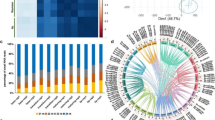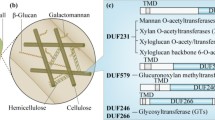Abstract
The microRNAs (miRNAs) are a newly identified class of small non-protein-coding regulatory RNA. Using comparative genomics, we identified 69 miRNAs belonging to 33 families in the domesticated soybean (Glycine max) as well as five miRNAs in the soybean wild species Glycine soja and Glycine clandestine. TaqMan® MicroRNA Assay analyses demonstrated that these miRNAs were differentially expressed in soybean tissues, with certain classes expressed preferentially in both a spatiotemporal and a tissue-specific manner. Detailed sequence analyses revealed that soybean pre-miRNAs vary in length from 44 to 259 nt with an average of 106 ± 45 nt, harbor mature miRNAs that differ in their physical location within the pre-miRNAs, and encode more than a single mature miRNA. Comparative sequence analyses of soybean miRNA sequences showed that uracil is the dominant base in the first position at the 5′ end of the mature miRNAs while cytosine is dominant at the 19th position, which is indicative that these two bases may have an important functional role in miRNA biogenesis and/or miRNA-mediated gene regulation. Soybeans were unique among plants in the frequency of occurrence of miRNA clusters. For the first time, antisense miRNAs were identified in plants. The five antisense miRNAs and their sense partners from soybean belonged to three miRNA families (miR-157, miR-162 and miR-396). Antisense miRNAs were also identified in soybean wild species. Mature antisense miRNA products appeared to have 1–3 nucleotide changes compared to their sense partners, which suggests that both strands of a miRNA gene can produce functional mature miRNAs and that antisense transcripts may differ functionally from their sense partners. Based on previously established in silico methods, we predicted 152 miRNA-targeted mRNAs, which included a large percentage of mRNAs that encode transcription factors that regulate plant growth and development as well as a lesser percentage of mRNAs that encode environmental signal transduction proteins and central metabolic processes.









Similar content being viewed by others

Abbreviations
- 3′ UTR:
-
3′ Untranslated region
- AMFE:
-
Adjusted MFE
- ap2 :
-
Apetal 2
- ARFs:
-
Auxin response factors
- CBF:
-
CCAAT-binding transcription factor
- EST:
-
Expressed sequence tag
- GSS:
-
Genome survey sequence
- GIF1:
-
GRF1-interacting factor 1
- HSP:
-
Heat shock protein
- miRNA:
-
MicroRNA
- MFEI:
-
Minimal folding free energy index
- pre-miRNAs:
-
miRNA precusor
- NCBI:
-
National Center for Biotechnology Information
- NAP:
-
Nucleosome assembly protein
- PCR:
-
Polymerase chain reaction
- qRT-PCR:
-
Quantitative real time PCR
- RISC:
-
RNA-induced silencing complex
- SBP:
-
Squamosa-promoter binding protein-like protein
References
Adams MD, Kelley JM, Gocayne JD, Dubnick M, Polymeropoulos MH, Xiao H, Merril CR, Wu A, Olde B, Moreno RF, Kerlavage AR, Mccombie WR, Venter JC (1991) Complementary DNA sequencing: expressed sequence tags and human genome project. Science 252:1651–1656
Allen E, Xie ZX, Gustafson AM, Sung GH, Spatafora JW, Carrington JC (2004) Evolution of microRNA genes by inverted duplication of target gene sequences in Arabidopsis thaliana. Nat Genet 36:1282–1290
Altschul SF, Madden TL, Schaffer AA, Zhang J, Zhang Z, Miller W, Lipman DJ (1997) Gapped BLAST and PSI-BLAST: a new generation of protein database search programs. Nucleic Acids Res 25:3389–3402
Altuvia Y, Landgraf P, Lithwick G, Elefant N, Pfeffer S, Aravin A, Brownstein MJ, Tuschl T, Margalit H (2005) Clustering and conservation patterns of human microRNAs. Nucleic Acids Res 33:2697–2706
Ambros V, Chen XM (2007) The regulation of genes and genomes by small RNAs. Development 134:1635–1641
Aukerman MJ, Sakai H (2003) Regulation of flowering time and floral organ identity by a microRNA and its APETALA2-like target genes. Plant Cell 15:2730–2741
Bender W (2008) MicroRNAs in the Drosophila bithorax complex. Genes Dev 22:14–19
Bonnet E, Wuyts J, Rouze P, Van de Peer Y (2004a) Detection of 91 potential in plant conserved plant microRNAs in Arabidopsis thaliana and Oryza sativa identifies important target genes. Proc Natl Acad Sci USA 101:11511–11516
Bonnet E, Wuyts J, Rouze P, Van de Peer Y (2004b) Evidence that microRNA precursors, unlike other non-coding RNAs, have lower folding free energies than random sequences. Bioinformatics 20:2911–2917
Carrington JC, Ambros V (2003) Role of microRNAs in plant and animal development. Science 301:336–338
Chen CF, Ridzon DA, Broomer AJ, Zhou ZH, Lee DH, Nguyen JT, Barbisin M, Xu NL, Mahuvakar VR, Andersen MR, Lao KQ, Livak KJ, Guegler KJ (2005) Real-time quantification of microRNAs by stem-loop RT-PCR. Nucleic Acids Res 33:e179
Chen XM (2004) A microRNA as a translational repressor of APETALA2 in Arabidopsis flower development. Science 303:2022–2025
Chen XM (2005) microRNA biogenesis and function in plants. FEBS Lett 579:5923–5931
Chiou TJ (2007) The role of microRNAs in sensing nutrient stress. Plant Cell Environ 30:323–332
Floyd SK, Bowman JL (2004) Gene regulation: ancient microRNA target sequences in plants. Nature 428:485–486
Gleave AP, Ampomah-Dwamena C, Berthold S, Dejnoprat S, Karunairetnam S, Nain B, Wang Y-Y, Crowhurst RN, MacDiarmid RM (2008) Identification and characterisation of primary microRNAs from apple (Malus domestica cv. Royal Gala) expressed sequence tags. Tree Genet Genomes 4:343–358
Griffiths-Jones S (2004) The microRNA registry. Nucleic Acids Res 32:D109–D111
Griffiths-Jones S, Grocock RJ, van Dongen S, Bateman A, Enright AJ (2006) miRBase: microRNA sequences, targets and gene nomenclature. Nucleic Acids Res 34:D140–D144
Guo Q, Xiang AL, Yang Q, Yang ZM (2007) Bioinformatic identification of microRNAs and their target genes from Solanum tuberosum expressed sequence tags. Chin Sci Bull 52:2380–2389
Jones-Rhoades MW, Bartel DP (2004) Computational identification of plant microRNAs and their targets, including a stress-induced miRNA. Mol Cell 14:787–799
Juarez MT, Kui JS, Thomas J, Heller BA, Timmermans MCP (2004) MicroRNA-mediated repression of rolled leaf1 specifies maize leaf polarity. Nature 428:84–88
Kim JH, Kende H (2004) A transcriptional coactivator, AtGIF1, is involved in regulating leaf growth and morphology in Arabidopsis. Proc Natl Acad Sci USA 101:13374–13379
Lauter N, Kampani A, Carlson S, Goebel M, Moose SP (2005) MicroRNA172 down-regulates glossy15 to promote vegetative phase change in maize. Proc Natl Acad Sci USA 102:9412–9417
Lee Y, Kim M, Han JJ, Yeom KH, Lee S, Baek SH, Kim VN (2004) MicroRNA genes are transcribed by RNA polymerase II. EMBO J 23:4051–4060
Llave C, Xie ZX, Kasschau KD, Carrington JC (2002) Cleavage of Scarecrow-like mRNA targets directed by a class of Arabidopsis miRNA. Science 297:2053–2056
Lohmann JU, Weigel D (2002) Building beauty: the genetic control of floral patterning. Dev Cell 2:135–142
Lu SF, Sun YH, Shi R, Clark C, Li LG, Chiang VL (2005) Novel and mechanical stress-responsive microRNAs in Populus trichocarpa that are absent from Arabidopsis. Plant Cell 17:2186–2203
Maher C, Stein L, Ware D (2006) Evolution of Arabidopsis microRNA families through duplication events. Genome Res 16:510–519
Mallory AC, Reinhart BJ, Jones-Rhoades MW, Tang GL, Zamore PD, Barton MK, Bartel DP (2004) MicroRNA control of PHABULOSA in leaf development: importance of pairing to the microRNA 5′ region. EMBO J 23:3356–3364
Mathews DH, Sabina J, Zuker M, Turner DH (1999) Expanded sequence dependence of thermodynamic parameters improves prediction of RNA secondary structure. J Mol Biol 288:911–940
Matukumalli LK, Grefenstette JJ, Sonstegard TS, vanTassell CP (2004) EST-PAGE: managing and analyzing EST data. Bioinformatics 20:286–288
Pan XP, Zhang BH, SanFrancisco M, Cobb GP (2007) Characterizing viral microRNAs and its application on identifying new microRNAs in viruses. J Cell Physiol 211:10–18
Park W, Li JJ, Song RT, Messing J, Chen XM (2002) CARPEL FACTORY, a Dicer homolog, and HEN1, a novel protein, act in microRNA metabolism in Arabidopsis thaliana. Curr Biol 12:1484–1495
Pasquinelli AE, McCoy A, Jimenez E, Salo E, Ruvkun G, Martindale MQ, Baguna J (2003) Expression of the 22 nucleotide let-7 heterochronic RNA throughout the Metazoa: a role in life history evolution? Evol Dev 5:372–378
Pasquinelli AE, Reinhart BJ, Slack F, Martindale MQ, Kuroda MI, Maller B, Hayward DC, Ball EE, Degnan B, Muller P, Spring J, Srinivasan A, Fishman M, Finnerty J, Corbo J, Levine M, Leahy P, Davidson E, Ruvkun G (2000) Conservation of the sequence and temporal expression of let-7 heterochronic regulatory RNA. Nature 408:86–89
Reinhart BJ, Weinstein EG, Rhoades MW, Bartel B, Bartel DP (2002) MicroRNAs in plants. Genes Dev 16:1616–1626
Rhoades MW, Reinhart BJ, Lim LP, Burge CB, Bartel B, Bartel DP (2002) Prediction of plant microRNA targets. Cell 110:513–520
Schwab R, Palatnik JF, Riester M, Schommer C, Schmid M, Weigel D (2005) Specific effects of microRNAs on the plant transcriptome. Dev Cell 8:517–527
Stark A, Bushati N, Jan CH, Kheradpour P, Hodges E, Brennecke J, Bartel DP, Cohen SM, Kellis M (2008) A single Hox locus in Drosophila produces functional microRNAs from opposite DNA strands. Genes Dev 22:8–13
Subramanian S, Fu Y, Sunkar R, Barbazuk WB, Zhu JK, Yu O (2008) Novel and nodulation-regulated microRNAs in soybean roots. BMC Genomics 9:160
Sunkar R, Girke T, Jain PK, Zhu JK (2005) Cloning and characterization of MicroRNAs from rice. Plant Cell 17:1397–1411
Sunkar R, Jagadeeswaran G (2008) In silico identification of conserved microRNAs in large number of diverse plant species. BMC Plant Biol 8:37
Sunkar R, Zhu JK (2004) Novel and stress-regulated microRNAs and other small RNAs from Arabidopsis. Plant Cell 16:2001–2019
Talmor-Neiman M, Stav R, Frank W, Voss B, Arazi T (2006) Novel micro-RNAs and intermediates of micro-RNA biogenesis from moss. Plant J 47:25–37
Tanzer A, Stadler PF (2004) Molecular evolution of a microRNA cluster. J Mol Biol 339:327–335
Tyler DM, Okamura K, Chung WJ, Hagen JW, Berezikov E, Hannon GJ, Lai EC (2008) Functionally distinct regulatory RNAs generated by bidirectional transcription and processing of microRNA loci. Genes Dev 22:26–36
Xie FL, Huang SQ, Guo K, Xiang AL, Zhu YY, Nie L, Yang ZM (2007) Computational identification of novel microRNAs and targets in Brassica napus. FEBS Lett 581:1464–1474
Zhang BH, Pan XP, Anderson TA (2006a) Identification of 188 conserved maize microRNAs and their targets. FEBS Lett 580:3753–3762
Zhang BH, Pan XP, Cannon CH, Cobb GP, Anderson TA (2006b) Conservation and divergence of plant microRNA genes. Plant J 46:243–259
Zhang BH, Pan XP, Cobb GP, Anderson TA (2006c) Plant microRNA: a small regulatory molecule with big impact. Dev Biol 289:3–16
Zhang BH, Pan XP, Cox SB, Cobb GP, Anderson TA (2006d) Evidence that miRNAs are different from other RNAs. Cell Mol Life Sci 63:246–254
Zhang BH, Pan XP, Wang QL, Cobb GP, Anderson TA (2005) Identification and characterization of new plant microRNAs using EST analysis. Cell Res 15:336–360
Zhang BH, Pan XP, Wang QL, Cobb GP, Anderson TA (2006e) Computational identification of microRNAs and their targets. Comput Biol Chem 30:395–407
Zhang BH, Wang QL, Pan XP (2007a) MicroRNAs and their regulatory roles in animals and plants. J Cell Physiol 210:279–289
Zhang BH, Wang QL, Wang KB, Pan XP, Liu F, Guo TL, Cobb GP, Anderson TA (2007b) Identification of cotton microRNAs and their targets. Gene 397:26–37
Zhang YJ (2005) MiRU: an automated plant miRNA target prediction server. Nucleic Acids Res 33:W701–W704
Zuker M (2003) Mfold web server for nucleic acid folding and hybridization prediction. Nucleic Acids Res 31:3406–3415
Acknowledgments
This work was supported by East Carolina University New Faculty Research Startup Funds Program (BZ), Western Illinois University New Faculty Research Startup Funds Program (XP), and a Science and Engineering Grant from DuPont (BZ). We would like to thank Dr. Joseph Burton of ARS, USDA for kindly providing soybean seeds. We also appreciate Dr. Brian McGonigle of DuPont for his support and encouragement.
Author information
Authors and Affiliations
Corresponding author
Electronic supplementary material
Below is the link to the electronic supplementary material.
425_2008_818_MOESM1_ESM.doc
MOESM1 Schematic representation of the miRNA gene search procedure for identifying soybeanhomologs based on established Arabidopsis miRNAs (DOC 121 kb)
Rights and permissions
About this article
Cite this article
Zhang, B., Pan, X. & Stellwag, E.J. Identification of soybean microRNAs and their targets. Planta 229, 161–182 (2008). https://doi.org/10.1007/s00425-008-0818-x
Received:
Accepted:
Published:
Issue Date:
DOI: https://doi.org/10.1007/s00425-008-0818-x



